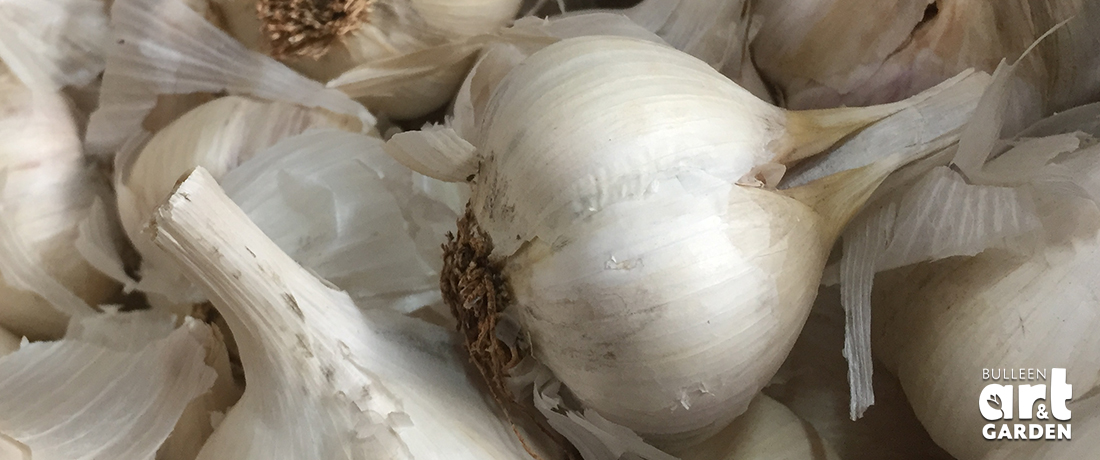
 Important note about plant availability. Important note about plant availability.There are hundreds of factsheets on our website provided for your information. Not all plants will be available at all times throughout the year. To confirm availability please call (03) 8850 3030 and ask for the nursery. |
Garlic has been around for thousands of years, dating as far back as the Egyptian pyramids. It has been widely used as both food and medicine in many cultures over the years. Garlic is really easy to grow if you plant it at the right time. If you would like a garlic flavour in your cooking all year round you can plant garlic chives as well. When buying garlic to plant, be sure to buy healthy, firm bulbs from a garden centre or garlic farm. You cannot grow bulbs bought from the supermarket as they are treated to prevent them from sprouting.
Another great reason to grow your own organic garlic at home is that ALL imported garlic, under Australian customs regulations, is sprayed with methyl bromide.
Varieties
There are three types of Garlic available to grow in Australia.
Softnecks
Generally smaller cloves but store the longest after harvest. These types usually have a strong pungent flavour. Varieties include California Early, Italian White, South Australian White and California Late.
Hardnecks or Topsets
These are usually larger fat, flavourful bulbs, that are easy to peel and are often pretty looking with purple colours or streaks. These varieties include Australian White, Chinese Pink, German White, New Zealand Purple, Italian Purple and New York White.
Elephant Garlic
Elephant garlic is not actually garlic, but in fact, a Leek. The bulbs can be very large, mild in flavour but can also be a bit bitter. These do not store well, so are really just a bit of fun to grow in the garden.
Planting
In general, plant autumn-winter in a sunny spot in well drained soil, pointy end up so they are just below the surface. Drainage is important to avoid rotting the developing bulbs. Like onions, they will not grow well in acid soils, so sprinkle around some dolomite or garden lime at planting. Adding potash and some mild compost is fine too.
Garlic is traditionally planted just after the autumn equinox (around March 20th) for maximum growing time. This is because the shorter days make the leafy part of the garlic grow. When we pass the spring equinox (around September 22nd), the energy stored in the leaves starts getting used to make you some nice fat garlic bulbs for the summer harvest. You can plant later than this but the later you leave it, the less leafy growth there is to feed the bulb.
Garlic plants, like onions, prefer a more alkaline soil. Sprinkle some dolomite or garden lime around the area before planting. Single cloves can often form large, single bulbs, called rounds, in their first year. If these are kept and planted out next autumn they will form large, multi-cloved bulbs in their second year.
Feeding
Overfeeding with manures is not recommended as it will encourage rot. You are far better off planting in a soil that was enriched for the crop beforehand. Garlic will really benefit from regular seaweed fertiliser applications, especially in spring. Keeping the soil evenly moist will aid bulb development, but don’t overwater.
Harvest
Bulbs develop in spring / summer, and can be harvested on a dry day when the leaves are starting to turn yellow. A tip is to bend the foliage and flower stem to the ground in late spring / summer. This helps to put more energy into the bulb. Dry your garlic and then brush off the excess dirt from it before storage. They look great and store well if you plait the stems together and hang them in a cool, airy spot away from direct sun.
Uses
What’s a pizza, a garlic bread or a stir fry without garlic? You can use garlic to flavour any savoury dish… pizza, pasta, meats, stirfries, stews, butter, bread. Its use is really only limited by your imagination in the kitchen.
If you’re worried about your breath after eating garlic, chewing on some parsley helps neutralise the smell.
Medicinally, garlic fights infections, colds and flu… and is a natural antibiotic and immune booster.
